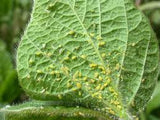Dealing with Aphids
Posted October 03, 2012


At one time or another it seems like gardeners have to deal with aphids in the garden, greenhouse or cold frames. They are sometimes called 'greenfly' but not commonly in the US. Typically they are the worse in the spring time, but as we have seen them build a resistance, they can hang out through generations, year round in warmer regions and become a problem in greenhouses. These pests are a teardrop shape with six legs and no larger than 3mm long. Aphids can be green, yellow, blue-green, pinkish-brown and even black. Some have wings while others don't. They feed by sucking plant sap through fine tubular mouth parts, which they insert into plant cells, and you'll usually spot them hiding on the undersides of young leaves or on the bud tips in the spring. There are specific types of aphids for particular plants. Plums for example attract the leaf-curling aphid and cabbage aphid feeds on brassica. There are more than 1,300 species of aphids in North America.
In the spring the adult female aphid will give birth to live young without mating. These young nymphs are all female, so numbers can build up very rapidly. The newly born aphids carry more young ones inside them so new crops of aphids are constant. Certain environmental conditions stimulate production of winged forms like overcrowding and day length. As autumn approaches, they very cleverly produce eggs that will overwinter. If you don't control them, they'll soon take over.
When inspecting plants, it may be the honeydew you spot. This is a sticky sugar-rich liquid that is excreted as they feed. As the pests travel from plant to plant, they may transmit viruses. They can cause distortion of flowers and fruits. During the spring when fruit trees are in bloom, aphids can take over and literally 'suck' the life out of fruit trees and kill them if they are not controlled. Honeydew also supports the growth of a black sooty mold that can, in severe cases, affect the entire plant.
The key to successful control is using an insecticidal soap or hot pepper wax as a preventive. The very next best thing is to treat them at the first signs of damage, using Endall or Neem PY are good organic choices. Make sure when you are spraying when the aphids are present, to spray the undersides of the leaves. Contact is always better. If aphids have taken over, it's much more difficult to element them. A second or even third spray may be necessary.



Comments (1 Comment)
It’s true! If you don’t get these pests early they do take over. I released ladybugs, but they all flew away. The insect soap helped but didn’t get them all so I had to use neem, but I did have to spray twice because they were really bad but that finally got them!
Thanks for the post!
Posted by Carol M. on October 03, 2012
Post Comment